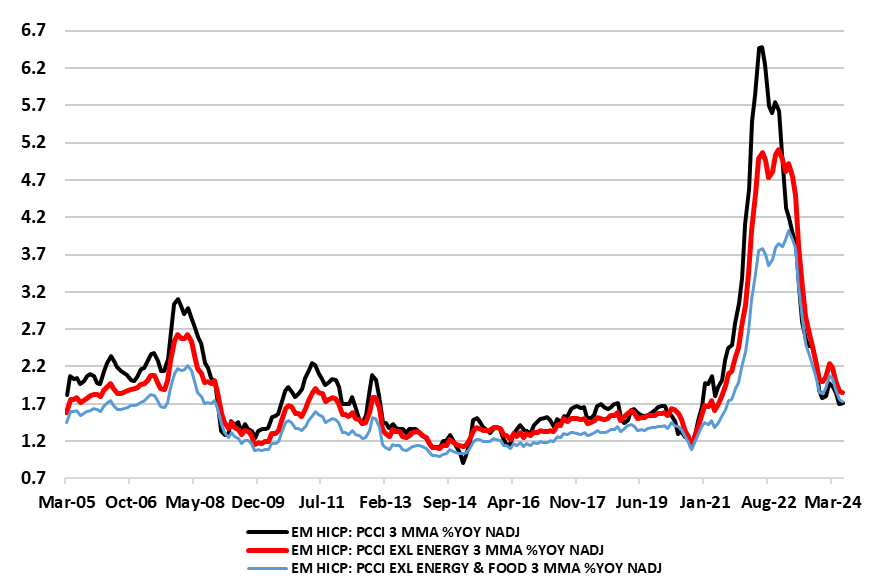EZ HICP Preview (Jul 31): Disinflation Continues - Below-Target Rate Looming?
The clear disinflation trend was still evident even after higher and higher-than-expected May numbers, where the headline moved up from 2.4% to a three-month high of 2.6%. That disinflation trend looks more discernible after the partial drop back to 2.5% seen in the June HICP, albeit with some far from reassuring signs of resilience in a stable core of 2.9%, partly driven by stable services inflation at 4.1%. But more reassuring numbers and on a broad basis should emerge in the July flash HICP (Figure 1). Indeed, we see a 0.2 ppt drop in the headline to a three-year low of 2.3%, alongside a same-sized fall in the core to 2.7%, a 29-mth low. Instrumental in this will be some slowing in services inflation back to(ward) the April low of 3.7% and where this more reassuring set of price data will be echoed in m/m adjusted numbers (Figure 2). If accurate, such data will help temper worries about persistent prices even though measures assessing such pressures directly are very much suggesting broad-based disinflation (Figure 3).
Figure 1: Headline and Core Falls Further?

Source: Eurostat, CE
The July drop in the headline may come in spite of a small rise in fuel costs, but this should be offset by food price inflation (actually back down to around 2%). Most notable will be reassuring and belated slowing in services inflation, albeit only back to(ward) the April low of 3.7%. This will be driven by base effects, but also indicative of slightly slower m/m adjusted price dynamics. Indeed, this will be the case of the core rate too where we see adjusted data down again, and with the m/m numbers of late already down to a arte just above that consistent with target (Figure 2)
Figure 2: Short-Run Core Inflation Pressures Still Easing?

Source: Eurostat, ECB, CE
Supply or Demand?
One topic here and one mentioned in a speech yesterday by President Lagarde was the extent to which the recent inflation surge was more supply or instead demand determined. This is still a topic of big debate and disagreement, partly depending upon what part of the global economy one is more guided by. Indeed, economists at the IMF influenced more by matters-USA seem to think that inflation has been demand driven while an ECB paper suggest the opposite. Indeed, it notes that ‘shocks linked to global supply chains and to gas prices have exhibited a much larger influence than in the past. Overall, supply shocks can explain the bulk of the post-pandemic inflation surge, also for core inflation’.
This latter view is one with which we agree and can provide evidence to substantiate. Notably ECB Chief Economist Lane has very much underscored that the Persistent and Common Component of Inflation (PCCI) is the best predictor of inflation one and two years ahead and this is all the more notable as this measures have eased to below 2% of late and stayed there (Figure 3). Given that it perhaps the best measure of price persistence, it is already arguing that worries about services price resilience are overdone.
Figure 3: Persistent Price Pressures Have Ebbed Further and to Below Target

Source: ECB, PCCI is Persistent and Common Component of Inflation
Indeed, actually suggesting not only below target price pressures even on an overall basis but also at the core level with the latest PCCI core outcome at 1.7% this being only a few notches above its pre-pandemic average and having fallen of late as fast it rose previously. Furthermore, the PCCI measure very much offers lead properties, having repeatedly foreshadowed HICP inflation turning points in the past. An added reassurance comes from the fact that its recent slowing is an indication that price pressures are not broadening out, the very opposite. This is because the PCCI captures widespread developments across the HICP basket that are persistent (hence the name), this being all more crucial as the ECB hawks apparent focus is on preventing the recent inflation surge becoming embedded.
All of which may feature more clearly in headline HICP numbers ahead. We see a below target outcome later this summer before energy base effects take the rate back towards 2.5% by year, only for a more durable drop back below target next spring!